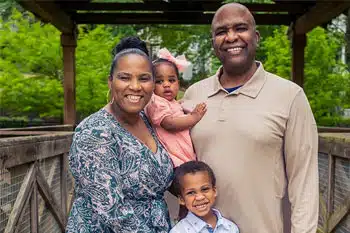
Looking at all the smiling faces of other couples waiting to adopt, she wondered to herself, “How will we stand out from the other couples? What would make a birth mother pick us to be the parents of her child? How can we compete with so many couples who are more attractive, more educated, or wealthier?”
Does this scenario sound familiar? Many hopeful adoptive parents can relate to the fear that a birth mother won’t pick them. Struggling with jealousy and frustration during the adoption wait is normal. Many couples think, “I hope we get the call soon,” or wonder, “Why wasn’t this our adoption?”
In this article, I hope to clarify the open adoption process and provide you with some bottom line facts about being picked by a birth mother.
Table of Contents
- Why Them and Not Us?
- How Long Will It Take?
- Why Wasn’t That Our Baby?
- Preparing Emotionally and Practically for Your Adoption
- Addressing Common Misconceptions
- Why Do Some Wait Longer?
- Additional Support and Educational Resources
Why Them and Not Us?
Just as adoptive parents have preferences in adoption, so do birth mothers. In your adoption preferences, you can name the age, gender, and ethnicity of the child you’re open to adopting. A birth mother may have a wide array of preferences in open adoption. She may prefer a couple who lives in a certain region of the U.S., one with a stay-at-home mom, or an adoptive family of a particular race; the list goes on.
In today’s adoptions, birth mothers select adoptive families for all sorts of reasons. Lifetime has seen families chosen because they looked familiar, kind, or fun. Birth mothers have chosen their baby’s family based on their pets, where they live, or their hobbies. We’ve even worked with birth mothers who felt a connection to an adoptive couple based on their favorite candy! As you can see, there isn’t a predictable reason why a birth mother might like one family over another.
The reality is that a birth mother can only choose ONE adoptive family for her baby. As she comes to realize that there are many wonderful couples who would make amazing parents for her child, her decision becomes even more difficult.
How Long Will It Take?
The adoption journey is truly unique and unpredictable. If it were easy, more people would pursue it. It’s difficult to predict precisely how long your adoption wait will be. Sometimes, a birth mother will choose a couple who’s only been waiting a few months, while other times, it takes up to two years or even more. At Lifetime, adoption depends on the birth mother’s choice, making each journey distinct and special.
As a result, it’s crucial to follow your adoption professional’s advice on optimizing your exposure to women thinking about adoption. Additionally, it’s essential to set your adoption preferences to be as open as you are comfortable. Each time a potential birth mother sees you results in another opportunity for her to choose you, and your professional is there to guide you through this process.
Why Wasn’t That Our Baby?
When a woman who is considering adoption contacts Lifetime, we discuss what she’s hoping for in adoptive parents for her child. Then, we share adoptive family profiles that not only match her preferences but also match yours.
Once a birth mother chooses a few of her top picks in adoptive families, Lifetime presents her adoption situation to those families. If the adoptive couple decides to move forward, we’ll set up a time for them to talk with the birth mother on the phone.
When wondering why you weren’t selected, it helps to know that there are always details behind the scenes that Lifetime must keep confidential. These details may include substance use, mental health issues, and birth father issues. Rest assured, your privacy and the birth mother’s privacy are always respected in this process.
Preparing Emotionally and Practically for Your Adoption
While you wait to be chosen by a birth mother, comprehensive preparation goes beyond logistics. Here’s how to ready yourself on multiple levels:
Practical Preparations
- Make sure your home study is up to date and renewal dates are calendared
- Contact house sitters and pet sitters so they’ll be taken care of when you travel for your adoption
- Research the closest airports and transportation options for last-minute travel
- Prepare your home for a child: begin to assemble the nursery and research baby gear
- Prepare your life for a child: discuss leave policies at work, attend childcare classes, read parenting books
- Practice “what if” scenarios (for example, we call you about a situation across the country, and you need to be there by 5 pm. How will you make that happen?)
Emotional and Relationship Preparations
- Develop healthy coping strategies for managing anxiety and disappointment during the wait
- Strengthen your support network by connecting with other adoptive families, either locally or online
- Practice communication skills for conversations about adoption with family, friends, and eventually with your child
- Consider counseling or therapy to process emotions around infertility, loss, or adoption-related stress
- Plan meaningful activities and goals for the waiting period that aren’t adoption-focused
- Discuss expectations and fears openly with your partner to stay aligned throughout the process
- Create rituals or practices that help you stay grounded during uncertain times
Educational Preparations
- Access Lifetime’s exclusive listening library and educational opportunities, which cover adoption comprehensively
- Learn about communication and relationship-building in open adoption
- Research child development and attachment, particularly for adopted children
- Familiarize yourself with adoption terminology and processes
- Aim to stay engaged through regular check-ins with your adoption professional
Addressing Common Misconceptions
Many hopeful adoptive parents operate under misconceptions about what influences a woman’s choice of adoptive family. Let’s address some of the most common myths:
Myth: Wealth is the primary factor
Reality: While financial stability matters, women considering adoption rarely choose families based on who appears to have the most money.
They’re looking for emotional stability, love, and commitment. We’ve seen families living in modest apartments chosen over those with large homes because of their warmth and authenticity.
Myth: Physical attractiveness determines selection
Reality: Connection goes far deeper than photos. Women often choose families because they seem genuine and kind, or because they remind them of people they care about. Sometimes, it’s a shared interest, a beloved pet in a photo, or simply the feeling that “this feels right.”
Myth: Higher education levels guarantee faster placement
Reality: Educational background is just one factor among many. Some women prefer families with specific educational experiences, while others prioritize life experience, emotional intelligence, or shared values over formal education.
Myth: Certain family compositions are preferred
Reality: Every woman’s preferences are unique. Some prefer a stay-at-home mom, while others want working parents as role models. Some want to place their baby with a couple who already have children, while others prefer their baby be an only child.
Myth: “Perfect” profiles get chosen faster
Reality: Authenticity is more important than perfection. Families who present genuine glimpses into their lives—including their struggles, growth, and real personalities—often connect more deeply than those trying to appear flawless.
The truth is that matching in adoption is deeply personal and often involves factors that can’t be predicted or manufactured. Focus on presenting your authentic selves rather than trying to be what you think someone wants.
Why Do Some Wait Longer?
The truth is that there are reasons why some hopeful adoptive families wait longer than others. Some couples may have procrastinated with their home study paperwork or with their adoption profile. Or, they may even have declined an adoption opportunity that was presented to them and fell within their preferences. However, the reality is that it’s just a matter of time for couples who have been ready and proactive from the start.
Each adoption journey is unique, but it can be hard not to compare yours to others. Whether you’re searching on your own or with the help of a professional, hopefully, the insights shared in this article will help you get through the difficult or frustrating days.
Additional Support and Educational Resources
Beyond Lifetime’s comprehensive support system, consider accessing these valuable resources during your adoption journey:
Educational Resources
- Books: The Open-Hearted Way to Open Adoption by Lori Holden, The Adoptive Parent Toolbox by Mike and Kristin Berry
- Online Learning: StageWise Parenting offers courses on topics like attachment, trauma-informed parenting, and open adoption
- Podcasts: “Adoption Now,” “Creating a Family,” and “Let’s Talk Adoption” provide ongoing education and support
Support Networks
- Online Communities: Resolve.org‘s online support community, Creating a Family‘s Facebook groups, or Belonging Network‘s online discussion group for waiting parents.
- Local Support: Search for adoptive parent meetups in your area. The North American Council on Adoptable Children maintains a database of support groups you can search by location and type, including pre- and post-adoption groups.
- Professional Counseling: Seek therapists who specialize in adoption and fertility issues for additional emotional support
Practical Planning Tools
- Travel Preparation: Sign up for airline apps, research extended-stay hotels, and create travel checklists for adoption-related trips
- Financial Planning: Consult with financial advisors familiar with adoption costs and available grants or loans
- Workplace Resources: Review your employee handbook for adoption benefits and connect with HR about leave policies
Child Preparation Resources
- Parenting Classes: Look for adoption-specific parenting classes, such as Expecting 101…You’re Adopting
- Medical Preparation: Research pediatricians who are adoption-friendly and understand unique medical history considerations
Remember, your adoption journey is not just about waiting. It’s about growing, learning, and preparing to become the best parents you can be. These resources can help you use your waiting time productively while building the knowledge and support network that will serve your family for years to come.
Editor’s Note: This article was originally published on December 6, 2018, and has since been updated.
As Vice President of Lifetime Adoption, Heather Featherston holds an MBA and is passionate about working with those facing adoption, pregnancy, and parenting issues. Heather has conducted training for birth parent advocates, spoken to professional groups, and has appeared on television and radio to discuss the multiple aspects of adoption. She has provided one-on-one support to women and hopeful adoptive parents working through adoption decisions.
Since 2002, she has been helping pregnant women and others in crisis to learn more about adoption. Heather also trains and speaks nationwide to pregnancy clinics to effectively meet the needs of women who want to explore adoption for their child. Today, she continues to address the concerns women have about adoption and supports the needs of women who choose adoption for their child.
As a published author of the book Called to Adoption, Featherston loves to see God’s hand at work every day as she helps children and families come together through adoption.





0 Comments